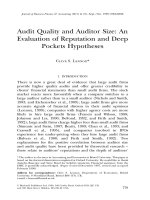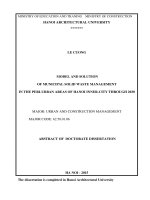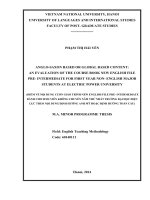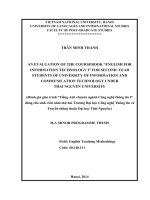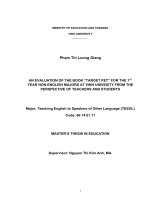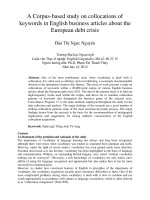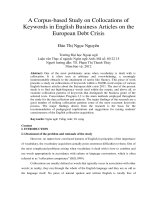Gis based multi criteria evaluation of suitable solid waste dis postal site selection, the case of hosanna, hadiya zone,ethiopian
Bạn đang xem bản rút gọn của tài liệu. Xem và tải ngay bản đầy đủ của tài liệu tại đây (4.21 MB, 93 trang )
ADDIS ABABA UNIVERSITY
COLLEGE OF SOCIAL SCIENCE DEPARTMENT OF
GEOGRAPHY AND
ENVIRONMENTAL STUDIES
GIS BASED MULTI-CRITERIAL EVALUATION OF SUITABLE S O L I D
W A S T E D I S P O SA L S I T E S E L E C T I O N,
THE CASE OF H O S A N A T O W N, H A D I Y A ZON E, E T H I O P I A
B Y: D E B E B E J A K A M O
JUNE, 2017
ADDIS ABABA UNIVERSITY, ETHIOPIA
GIS BASED MULTI-CRITERIAL EVALUATION OF SUITABLE S O L I D
W A S T E D I S P O S A L S I T E S E L E C T I O N,
THE CASE OF H O SA N A T O W N, H A D I Y A ZON E, E T H I O P I A.
A PROJECT SUBMITTED TO THE SCHOOL OF GRADUATE STUDIES OF
ADDIS ABABA UNIVERSITY, IN PARTIAL FULFILMENT OF THE
REQUIREMENTS FOR THE DEGREE OF MASTER OF ART IN
GEOGRAPHY AND ENVIRONMENTAL STUDIES SPECIALIZATION IN
GEOGRAPHIC INFORMATION SYSTEM AND REMOTE SENSING
B Y: D E B E B E J A K A M O
A D V I S O R: D r. TEBAREK LIKA
JUNE, 2017
ADDIS ABABA UNIVERSITY, ETHIOPIA
ADDIS ABABA UNIVERSITY
COLLEGE OF SOCIAL SCIENCE DEPARTMENT OF
GEOGRAPHY AND
ENVIRONMENTAL STUDIES
GIS BASED MULTI-CRITERIAL EVALUATION OF SUITABLE S O L I D
W A S T E D I S P O SA L S I T E S E L E C T I O N,
THE CASE OF H O S A N A T O W N, H A D I Y A ZON E, E T H I O P I A
Approved by board of examiners
Dr.
Signature
Date
Signature
Date
Signature
Date
Advisor
Dr.
Internal Examiner
Dr.
External Examiner
Dr.
Chairman
Signature
Date ________________
Declaration
I hereby declare that a project entitled “GIS based multi-criterial evaluation of Suitable Solid
Waste Disposal Site Selection, the case of Hosanna town, Hadiya zone, Ethiopia” has been
carried out by me under the supervision of Dr. Tebarek Lika, Department of Geography and
Environmental Studies, Addis Ababa University during the year 2016/17 as a part of Master of Art
program in Geography and Environmental Studies with specialization GIS, Remote Sensing and
Digital Cartography. I further declare that this work has not been submitted to any other University
or Institution for the award of any degree or diploma.
Place: Addis Ababa
Date: June 16, 2017
Debebe Jakamo ------------------------
Acknowledgements
My humble and special thanks go to the Almighty GOD, without whom many things could
have been impossible in all my life expeditions. Had it not been his benevolence, let alone
successful completion of my study, and all crossings in my life would have not been
rewarding.
I would like to express my heartfelt thanks and appreciations to my advisor Dr.Tebarek
Lika for his unreserved, guidance and encouragement to undertake this research and
devoted a lot of his time in correcting, guiding, and shaping both my proposal and final
paper.
Secondly, my special thanks and deepest gratitude goes to my wife Sitota (kebu) Solomon
for unreserved financial and moral support that she rendered to me during the whole years
of my stay in the university.
I also would like to thank my beloved sisters, Tigi and Masi Solomon who helped me in
moral support and coordinating my family and managing my kids.
My special thanks also to my friends: Daniel Nuramo, Chakebo Fora and Andineh
Ataro for their valuable moral support, encouragement, discussions. Their continuous
support, advice, discussions and suggestion guided me to become efficient during the work.
I would like to extend my sincere gratitude to Hosanna municipality, land
resource management and planning department for their collaboration when I
was in data collection.
i
Table of Contents
Acknowledgement ............................................................................................................. i
Table of contents ................................................................................................................ ii
List of Table ....................................................................................................................... v
List of Figures ..................................................................................................................... vi
Acronyms ............................................................................................................................ vii
Abstract ............................................................................................................................... viii
CHAPTER ONE ............................................................................................................... 1
1. Introduction ................................................................................................................... 1
1. Statement of the problem .......................................................................................... 3
1.2. Objective of the Study ........................................................................................... 5
1.2.1. General Objective ......................................................................................... 5
1.2.2. Specific objective .......................................................................................... 5
1.3. Research questions ................................................................................................. 5
1.4. Significance of the study........................................................................................ 5
1.5. Scope of the study .................................................................................................. 6
1.6. Limitation of the study ........................................................................................... 6
1.7. Organization of the paper....................................................................................... 6
CHAPTER TWO .............................................................................................................. 7
2. Review of related Literatures .......................................................................................... 7
2.1. General Concepts and Definition of Terms ........................................................... 7
2.2. Types of Solid Waste ............................................................................................. 7
2.2.1. Municipal solid waste ................................................................................. 7
2.2.2. Hazardous waste ......................................................................................... 7
2.2.3. Hospital waste ............................................................................................. 8
2.3. Solid waste management in developed countries .................................................. 8
2.4. Solid waste management in developing countries. ................................................ 9
2.5. Methods of Solid Waste Disposal .......................................................................... 9
2.5.1. Incineration ................................................................................................... 10
2.5.2. Recycling ...................................................................................................... 10
2.5.3. Source reduction ........................................................................................... 11
2.5.4. Landfill.......................................................................................................... 12
2.6. Landfill Sitting ....................................................................................................... 14
ii
2.7. Concept of dump sites............................................................................................ 15
2.8. Common landfilling methods ................................................................................ 15
2.8.1. Excavated cell/ trench method ...................................................................... 15
2.8.2. Area method ................................................................................................. 16
2.8.3. Canyon/Depression method. ......................................................................... 16
2.9. Landfill Site Selection Process............................................................................... 16
2.10. Criteria used for waste disposal site selection ..................................................... 21
2.11. Application of Remote Sensing for Landfill Site Selection................................. 22
2.12. Application of GIS for Landfill Site Selection .................................................... 22
2.13. Multi-Criteria Decision Analysis (MCDA) ......................................................... 23
CHAPTER THREE ..........................................................................................................25
3. Description of Study Area .....................................................................................................................25
3.1. Geographical location ............................................................................................25
3.1.1. Climate ..........................................................................................................26
3.1.2. Rain fall.........................................................................................................27
3.1.3. Physical characteristics ................................................................................28
3.1.4. Population: ...................................................................................................28
3.1.5. Economic activity .........................................................................................28
3.2 Methods and materials ............................................................................................28
3.2.1. Data Sources .................................................................................................29
3.2.2. Primary Data sources ....................................................................................29
3.2.3. Secondary Data sources ................................................................................30
3.3. Data analysis and presentation methods ................................................................30
3.3.1. Buffering .......................................................................................................30
3.3.2. Reclassify....................................................................................................................... 31
3.3.3. Overlay ..........................................................................................................31
3.3.4. Multi-criteria decision making (MCDM) ......................................................31
3.3.5. Analytic Hierarchy process (AHP)................................................................31
3.3.6. Conceptual framework of the analyses .........................................................33
CHAPTER FOUR .............................................................................................................34
4. Data Analysis, Result and Discussion..........................................................................34
4.1. Solid Waste Management System in Hossana Town ............................................34
4.1.1. Open solid waste disposal at the study area .................................................35
4.1.2. Illegal solid waste disposal in the hossana town. .........................................37
iii
4.2. Landfill site selection criteria ................................................................................37
4.2.1. Geological criteria .........................................................................................38
4.2.2. Urban land use criteria ..................................................................................40
4.2.3. Urban center criteria .....................................................................................43
4.2.4. Settlement area criteria .................................................................................45
4.2.5. Proximity from road ......................................................................................48
4.2.6. Slope criteria .................................................................................................52
4.2.7. Surface water criteria ....................................................................................56
4.2.8. Soil criteria ..................................................................................... 61
4.3. Potential landfill site analyses ................................................................................64
4.3.1. Calculating factor weight ..............................................................................64
4.3.2. Evaluating candidate landfill sites ................................................................70
CHAPTER FIVE ..............................................................................................................73
5 Conclusion and Recommendations ..................................................................................73
5.1. Conclusion .............................................................................................................73
5.2. Recommendations ..................................................................................................74
6. References………………………………………………………………………………75
iv
List of Tables
Table3.1 Sources and types of secondary data ................................................................... 30
Table2: method and software……………………………………………………………...32
Table 4.1 Landfill site selection criteria ............................................................................. 38
Table4.2: Land use suitability ............................................................................................. 41
Table4.3: Land use suitability comparison ......................................................................... 41
Table4.4 protected area suitability ...................................................................................... 46
Table4.5: Road network suitability ..................................................................................... 50
Table4.6: Slops Suitability ....................................................................................................... 54
Table 4.7: Rivers and streams proximity suitability ........................................................... 59
Table 4.8: Soil suitability of the study area ........................................................................ 64
Table 4.9: Random indices………………………………………………………………..68
Table4.10 .Pair wise comparison in 9 point continuous scale ............................................... 68
Table4.11: Weights derived by principal eigenvector of pair wise comparison matrix…..69
Table4.12: weight of suitable solid waste dumping site selection factors…………………70
Table4.13: Suitability area level and the percent of total area coverage ............................ 70
v
List of Figures
Figure 2.1: Steps in the landfill sitting process ................................................................... 20
Figure 3. 1: location map of the study area ......................................................................... 25
Fig 3.2: temperature map of the study area......................................................................... 26
Figure 3.3: rainfall map of the study area .......................................................................... 27
Figure 3.4: Suitability model……………………………………………………………...30
Figure 3.5: General Work flow chart……………………………………………………..33
Figure 4.1: open field solid waste disposal of the study area ............................................. 36
Figure 4.2: Illegal solid waste disposal in the hossana town .............................................. 37
Figure 4.3: Major Land Use Categories ............................................................................. 42
Figure 4.4: Urban center map of the hosanna town ............................................................ 43
Figure 4.5: Urban center suitability map ............................................................................ 44
Figure 4.6: Settlement area map ......................................................................................... 46
Figure 4.7: Settlement area suitability map ........................................................................ 47
Figure 4.8: Road network of the study area map ................................................................ 48
Figure 4.9: Road network suitability .................................................................................. 51
Figure 4.10: Digital Elevation Map.............................................................................................. 52
Figure 4.11: slop map of the study area ....................................................................................... 53
Figure 4.12: Slops Suitability map ..................................................................................... 55
Figure 4.13: Drainage map of the study area ...................................................................... 57
Figure 4.14: Rivers and streams proximity suitability ........................................................ 60
Fig 4.15: Soil map of the study area ................................................................................... 63
Figure 4.16: Landfill Suitability Map ................................................................................. 69
Figure 4.17: Overall Landfill Suitability Map .................................................................... 71
vi
Lists of Abbreviations and Acronyms
AHP:
Analytic Hierarchy Process
a.m.s.l:
above mean sea level
CSA:
Central Statics Authority
DEM:
Digital Elevation Model
EMA:
Ethiopian Mapping Agency
ERDAS:
Earth Resource Data Analysis System
ETM+:
Enhanced Thematic Mapper+
FOA
World food and Agriculture Organization
GIS:
Geographic Information System
GLCF:
Global Land Cover Facilities
GPS:
Global Positioning System
GSE:
Geological Survey of Ethiopia
LU / LC:
Land Use/ Land cover
MCDA:
MCE:
MWIE:
Multi Criteria Decision Analysis
Multi Criteria Evaluation
Ministry of Water, Irrigation and Electricity
MUDC:
Ministry of Urban Development and Construction
NUPI:
National urban plan institution
UTM:
Universal Transverse Mercator
3D:
Three Dimensional
vii
Abstract
Solid waste management system is the most difficult task that many countries, both developing
and developed, are facing. Landfill method is one of the easy and cheap management systems
which are always needed for sustainable management of solid waste. The main objective of the
study was to select landfill site for the town that is environmentally sound, socially
acceptable and economically feasible in Hosanna town. To achieve the objectives, the present
study was conducted by integrating Geographic Information System (GIS) and remote sensing
for selecting suitable solid waste disposal sites. All the factors were represented with map
outputs which were reclassified and standardized in GIS environment followed by preparation
of their suitability map. Analytical Hierarchy Processes pair-wise comparison module was
used to derive weights for all factor parameters.
Accordingly, 89% of the study area is unsuitable, 1.6% of the total study area is less
suitable, 2.9% is moderately suitable and 6.5% is highly suitable for landfill based on predefined criteria (based on their area, distance from the center and nearby settlements due to
their minimum environmental and social negative effects). The final output of the study shows
that 4 selected landfill sites in relation to those evaluating criteria. Therefore, landfill sites 4
which are chosen as highly suitable sites arranged based on their area size from large to
small area size,site1(97.1ha), landfill site,2(45.7ha), landfill site,3(29.2)and landfill
site4(23.1ha). In general, landfill site selection has been required appropriate data set,
consideration of responsible persons and other concerned bodies.
viii
8
CHAPTER ONE
1. INTRODUCTION
1.1 Background
Waste was an early problem of mankind, and a growing one that is of major concern to
every nation of the world (Genemo, et al, 2015). It is an issue mostly witnessed in urban areas
as a result of high surge in population growth rate and increase per capita income thus posing a
danger to environmental quality and human health. Waste is a material discharged from
each stage of daily human life activities which lead to impose impact on human health and
the environment, whereas
solid
waste refers to
leaves/twinges, food remnants, papers/
cartons, textile materials, bones ash/dust/stones dead animals, human and animals excreta,
construction and demolished debris, biomedical debris, household hardware (electrical
appliances, furniture etc…) ( Babatunde et al., 2013).
Solid waste is a global environmental problem in today’s world both developed
and developing countries due to rapid population growth, economic activities growth and
the rise of community demand accelerated solid waste generation in the world(Tirusew,
2013). The most common problem associated with improper management of solid waste
includes disease transmission, fire hazards, odder nuisance, atmospheric and water
pollution, aesthetic nuisance and economic loss (Jilani et al.,2002).
For many underdeveloped nations municipality solid waste management has thus
become a major issue of concern, especially as population increase. For instance, in most
developing countries 30-50% of the population is urban, and in many African countries the
growth rate of urban areas exceeds 4% (Senkoro, 2003).
When the government of African countries were asked by the
World Health
Organization to prioritize the environmental health concern, result revealed that solid
waste was identified as the second most important problem ( next to water quality), less
than 30% of urban population have access to “proper and regular garbage
removal
(Senakoro, 2003). The issue of solid waste management in developing countries, either not
efficient or still at the elementary stage, that is why solid waste generated has become a threat
to the environment.
1
Solid waste disposing is an important part of waste management system, which
requires much attention to avoid environmental pollution and health problem. However,
most solid waste dumping sites in developing countries are found on the outskirts of
the urban areas where there are water bodies, crop fields, settlement and road. These are a
suitable site for the incubation and proliferation of flies, mosquitos and rodents. They
transfer diseases that affect human health (Abul, 2010). Inappropriate disposal of solid waste
can be manifested by contamination of surface and ground water through leachate, soil
contamination through direct waste contact, air pollution by burning of waste, spread of
diseases by different vectors like birds, insects and rodents, or uncontrolled release of
methane by anaerobic decomposition of waste (Visvanathan and Glawe, 2006).
There are various techniques that are currently being used for solid waste
management. These include thermal treatment, biological treatment, land filling and recycling
(Kontos et al., 2005). However, in today’s society, finding a suitable site is becoming a
significant problem (Erkut and Moran, 1991).
The various factors such as socio-economic, environmental and land use should
be considered along people well-being for developing suitable solid waste disposal site. Today
advancement in remote sensing and Geographic information system (GIS) techniques has made
waste disposal site selection more accurate and convincing (Kontos, et al., 2005).
GIS undoubtedly provide better data management, high quality analysis and improve the
efficiency. The use of GIS reduce the time, cost and enhance accuracy (Akbari et al.,
2008).GIS is a tool that not only reduce time and cost of the site selection, but also provide
digital database for further monitoring program of the site.
2
1. Statement of the problem
Waste management is a major issue of the global environmental agenda, as population
and consumption growth result in increasing quantities of wastes. In developing countries, the
population of towns is increasing due to both natural increase and migration from rural areas.
This high population growth and the activities of development result in the generation of
large amount of solid wastes, that its composition includes paper, vegetable peelings, onion
seed coats, broken plastic and festal, soil and dust, animal dung, grasses, pieces of cloth, small
bottles, soot, etc.(Mekonin, 2012). Those solid wastes are face problem of their disposal and
have potential effect to pollute the environment like water, soil and air. The pollution of these
and other resources of the environment affects public health. In Ethiopia, most of the
diseases related to poor environmental sanitation and water contamination (Kumel, 2014).
Due to the fact that, rapid population growth and developmental activity, the Hosanna
town has been experiencing high amount of household and municipal solid wastes which are not
properly managed (Mekonin, 2012). These high rates of wastes are facing problem of their
disposal and have very high potential effect to pollute environment such as surface and ground
water, soil and air. The pollution of water could aid the transmission of water-borne infections
such as typhoid, gastro enteritis and the pollution of soil can aid the spread of f o o d - borne
diseases like salmonellosis (Nair, 2010). The existing solid waste management of the town is
improper and uncontrolled, where people dump wastes on the road street, market areas, water
drainages and so on. Uncontrolled solid waste disposal can also cause environmental
problems: - like traffic congestion on the streets and roads, municipal floods when dumped
on water ways (Nair, 2010).
There are economic and social drawbacks for the existing inefficient waste management
system of the town, such as absence of waste collection bins, lack of awareness and the habit
of waste collection centers proximity and open nature, unplanned existing dumping location site
problem and absence of transportation facilities. This leads to introduction of illegal dumpsites
that became fertile ground for breeding flies and other vectors which have in effect become
health hazard, obstructing traffic flow, causing environmental degradation and general
unsightliness (Hauwa, 2003). Therefore, the increased wastes from the growing population and
development activities have to be reduced via waste reduction, recycling and reuse techniques.
3
Despite the fact that, it is impossible to manage all solid wastes through waste reduction,
recycling and reuse system, collecting and depositing in proper sites by landfill techniques is
another means of
waste
disposal
(Kummel, 2016). The
landfill
sites should be
environmentally sound and socially accepted so as to protect environment and safeguard public
health. Even if it is more difficult to selecting appropriate site and managing solid waste
dumping in developing countries like Ethiopia with limited finance and rapid population growth
rate, the use of GIS and RS provide appropriate method to select landfill site more accurate,
cost and time efficient (Minalu,2016). However, in most part of our country the GIS and
RS techniques had been already using to conduct research on land fill site selection, but not
including Hosanna town.
The current
waste disposal system of the town is open dumping system where there
are river, stream, settlement and agricultural areas and the sites are filled out which
causing social and environmental problems. That is why, the research needed to conduct in order
to select suitable solid waste disposal site for the town by considering physical and social
factors. Therefore, the study employs Geographic information system (GIS) and remote
sensing techniques for appropriate solid waste disposal site selection for Hosanna Town.
4
1.2. OBJECTIVE OF THE STUDY
1.2.1 General Objective
The main objective of the study is to select suitable solid waste disposal sites which are
environmentally sound, economically feasible and socially acceptable in the study area.
1.2.2. Specific objective
1. To assess if the existing dumping sites fit the standards,
2. To examine the physical and social factors that are necessary to select landfill site and
prepare their suitability map in GIS environment, and
3. To determine potential solid waste disposal site by using multi-criteria analysis and
produce its thematic map.
1.3. Research questions
1. What does the present solid waste disposal system of the study area look like?
2. What are the solid wastes which dumped in outdoor in the study area?
3. What are the necessary factors to be considered to select suitable solid waste disposal site?
4. How would the final selected landfills be evaluated?
1.4. Significance of the study
This project is expected to ensure environmental safety of Hosanna town by
selecting suitable site for solid waste disposal using GIS and remote sensing which will
support different stakeholders like urban planners, local engineers in their activities to consider
the importance of free spaces and bare lands when urbanization and rapid growth rate of
population highly aggravates on the urban land.
In addition, there is no prior study in the study area; therefore, the final output of this
study will be used as springboard for further research on the issue of urbanization and
municipal solid waste management.
5
1.5. Scope of the study
This study is limited to the suitable solid waste disposal site selection for Hossana town.
The issues under consideration in this study are only solid waste disposal site selection, but
not the liquid waste and gaseous waste. Moreover, the study will be limited in technical aspects
for selecting suitable solid waste disposal site for Hossana town, rather recycling, reduction and
reusing waste management systems. In addition, the project conducting period is time bounded
until June 30/2017 G.C.
1.6. Limitation of the study
This study compiled with the limitation of the followings:
Lack of reliable data for some factors for the study area, even though the data collected at
national level are collected in a very wide range therefore the data lack well description
of the area. Hence, geology and ground water are not considered as suitable site selection.
Absence of prior study with regarding to landfill sitting in the study area to use as
comparative advantage.
Lack of organized secondary data due to the absence of documentation and organized
database system with regarding to the turnoff the officers in the study area.
1.7. Organization of the paper
The research paper has five chapters, the first chapter contains the introduction part
with background of the study, statement of the problem, objectives of the study, project
questions, scope, significance and limitation of the study. The second chapter is related to
literature reviewed, which focus on explaining terms, concepts related to the subject matter and
applications of GIS and RS in landfill sitting . This section is emphasized on different scholar’s
ideas about causes and consequences of landfill around the world. The third chapter deals with
descriptions of the study area, methodology and materials employed in this study. The fourth
chapter presents finding with the output representation of the study. The fifth chapter includes
conclusion and recommendations of the research work.
6
CHAPTER TWO
Review of Related Literatures
2.1. General Concepts and Definition of Terms
Solid Waste includes all products discarded a s useless or unwanted which arising from
human and animal activities those are normally solid and discarded once. Similarly, solid
wastes means any garbage, refuse, sludge and other discarded solid materials, including solid
waste materials resulting from industrial, commercial, and agricultural operations, and from
community activities, but does not include solid or dissolved materials in domestic sewage or
other significant pollutants in water resources, such as silt, dissolved or suspended solids in
industrial waste water effluents, dissolved materials in irrigation return flows or other common
water pollutants (Tchobanoglouset.al.1977 cited in Genemo 2015).
2.2. Types of Solid Waste
According to 2012 world bank report solid waste can be classified into different types
depending on their source:- municipal waste, hazardous waste and hospital waste.
2.2.1 Municipal solid waste
Municipal solid waste consists of household waste, construction and demolition debris,
sanitation residue, and waste from streets. This garbage is generated mainly from residential
and commercial complexes. With rising urbanization and change in lifestyle and food habits,
the amount of municipal solid waste has been increasing rapidly and its composition changing.
2.2.2. Hazardous waste
Industrial and hospital waste is considered hazardous as they may contain toxic
substances. Certain types of household waste are also hazardous. Hazardous wastes could be
highly toxic to humans, animals, and plants. Household wastes that can be categorized as
hazardous waste include old batteries, shoe polish, paint tins, old medicines, and medicine
bottles. Hospital waste contaminated by chemicals used in hospitals is considered hazardous.
These chemicals include formaldehyde and phenols, which are used as disinfectants, and
mercury, which is used in thermometers or equipment that measure blood pressure.
1 Municipal solid waste - www.epa.gov/epaoswer/non-hw/muncpl/index.htm
7
In the industrial sector, the major generators of hazardous waste are the metal, chemical,
paper, pesticide, dye, refining, and rubber goods industries. Direct exposure to chemicals in
hazardous waste such as mercury and cyanide can be fatal (Eberechi, 2016).
2.2.3. Hospital waste
Hospital waste is generated during the diagnosis, treatment, or immunization of
human beings or animals or in research activities in these fields or in the production or testing
of biological. It may include wastes like sharps, soild waste, disposables, anatomical waste,
cultures, discarded medicines, chemical wastes, etc. These are in the form of disposable
syringes, swabs, bandages, body fluids, human excreta, etc. This waste is highly infectious and
can be a serious threat to human health if not managed
in
a
scientific
and discriminate
manner
2.3. Solid waste management in developed countries
Shortage of land for waste disposal and inappropriate landfill site is one of the biggest
problems in most of the large urban area in the world which has its negative impact on human
and environment (Genemo, et al, 2015).
This extends wider than just the geographical boundaries of the town or municipalities.
Solid waste management is in crisis in many of the world’s largest urban areas as populations
attracted to cities continues to grow and this has led to ever increasing quantity of domestic solid
waste while space for disposal decrease (World Bank, 1999).
Solid waste management is the discipline associated with the control of generation,
storage, collection, transfer and transport, processing and disposal of solid wastes in a manner
that is in accord with the best principles of public health, economics, engineering, conservation,
aesthetics, and other environmental considerations, and that is also responsive to public attitudes.
Management of solid waste reduces adverse impacts on the environment and human health and
supports economic development and improved quality of life (Sener, 2004).
2 Municipal solid wastes -www.epa.gov/epaoswer/non-hw/muncpl/index.htm, Ibid,
8
2.4. Solid waste management in developing countries.
In Africa rapid urban growth since 1960’s has put pressure on land resources within the
areas surrounding cities, and has led to increased generation of wastes. The problem is
aggravated with the open dumping nature of disposing waste, especially in the slum areas
of most African cities (Hammer 2003 cited in Genemo 2015).
The booming growth of cities of the developing world has outpaced the financial and
man power resources of municipalities to deal with provision and management of services, of
which solid waste is the major one. Lack of these services greatly affects the urban poor, women
and children who are vulnerable to health hazards. Twenty two human diseases are related to
improper solid waste management (World Bank, 1999). Moreover, its effects are also reflected in
reduced productivity, low income and poor quality of life and deteriorated environment. Similar
to cities of most developing countries, provision of required services lags behind the need and
development of settlements in urban areas of Ethiopia.
Integrated infrastructure and housing development is not widely practiced. Provision of
solid and liquid waste collection and disposal is low (moisture ban are as lack the service). In
addition to this, deterioration of the immediate environment in the households and their
surrounding is increasing. With the current growth rate of urban population in Ethiopia, it is
estimated that the population of moisture ban are as especially small urban centers is doubling
every15-25years (World bank, 1999).
As solid waste generation increases with economic development and population growth,
the amount in these urban areas will double with in a similar time range. Municipalities in
Ethiopia have to be prepared for this challenge (Yohannis et al., 2015) with no exception of
Hossana Town.
2.5. Methods of Solid Waste Disposal
There are different methods used for waste management such as reuse, recycling,
incineration, landfill etc. In spite of the increasing stress towards the waste reduction at the
source, as well as recovery and recycling of the solid waste, disposal of solid waste by land
filling remains the most commonly employed methods (Debishiree, 2014).
9
2.5.1. Incineration
Incineration is a disposal method in which solid organic wastes are subjected to
combustion so as to convert them in to residue and gaseous products. This method is useful for
disposal of residue of both solid waste management and solid residue from waste water
management. This process reduces the volume of the solid waste to 20 to 30 percent of
the original volume. Incineration and other high temperature waste treatment systems are
sometimes described as “thermal treatment”. Incinerators convert waste materials in to heat, gas,
steam and ash. Incineration carried out both on a small scale by individuals and on a large scale
by industry. It is used to dispose of solid, liquid and gaseous waste. It is recognized as a
practical method of disposing of certain hazardous waste materials (such as biological
medical wastes). Incineration is a controversial method of waste disposal, due to issues such as
emission of gaseous pollutants. Combustion in an incinerator is not always perfect and there
have been concerns about pollutants in gaseous emission from incinerator stacks. Particular
concerns have focused on some very organics such as dioxins, furans, etc which may be created
which may have serious environmental consequences (Eberechi, 2016).
2.5.2. Recycling
Recycling is a resource recovery practice that refers to the collection and reuse of waste
materials such as empty beverage containers. The materials from which the items are made can
be reprocessed in to new products. Material for recycling may be collected separately from general
waste using dedicated bins and collection vehicles are sorted directly from mixed waste streams
and are known as kerb-side recycling, it requires the owner of the waste to separate it in to
various different bins (typically wheelie bins) prior to its collection(Lars, 1999).
The most common consumer products recycled include aluminum such as beverage cans,
copper such as wire, steel
and aerosol cans, old steel furnishings or equipment,
polyethylene, glass bottles and jars, paperboard cartons, newspapers, magazines and light paper,
and board boxes. These items are usually composed of a single type of material, making them
relatively easy to recycle in to new products. The recycling of complex products (such as
computers and electronic equipment) is more difficult, due to the additional dismantling and
separation requirement. The type of material accepted for recycling varies by city and country.
10
Each city and country has different recycling programs in place that can handle the various
types of recyclable materials (Eberechi 2016 and Sener, 2004).
However, certain variation in acceptance is reflected in the resale value of the material
on cities reprocessed. Methods of waste reduction, waste reuse and recycling are the preferred
options when managing solid waste. There are many environmental benefits that can be derived
from the use of these methods. They reduce or prevent greenhouse gas emissions, reduce the
release of pollutants, conserve resources, save energy and reduce the demand for waste
treatment technology and landfill space.
these
Therefore, it is advisable to adopt and incorporated
methods as part of the solid waste management plan (Mekonin, 2012).
Both waste reduction and reuse are methods of waste prevention which eliminates
the production of waste at the source of usual generation and reduce the demands for large scale
treatment and disposal facilities. Methods of waste reduction include manufacturing products
with less packaging, encouraging the public choose to reusable products such as cloth napkins,
reusable plastic and glass containers, backyard composting and sharing and donating any
unwanted items rather than discarding them (Mekonin, 2012).
Recycling refers to the removal of items from the waste stream to be used as raw
materials in the manufacture of new products. Thus, from this definition recycling occurs in
three phases: first the separation and collection of waste material (waste is sorted and
recyclables collected), the preparation of these materials for reuse, preprocessing and
remanufacturing of these materials ( recyclables are used to create raw materials). (Lars, 1999
and Sener, 2004).
2.5.3. Source reduction
It involves diminishing waste amount, volume and toxicity at a source of generation.
Source reduction is the most effective way which reduces the quantity of waste, the cost
of associated with its handling and its environmental impact (Sener, 2004).
Waste reduction may occur through the design, manufacture and packaging of products
with minimum toxic content, minimum volume of materials, or longer life and also at the
11
household, commercial or industrial facility through selective buying patterns and the reuse of
products and materials (Tehobanoglous ,1993 cited in Sener, 2004).
2.5.4. Landfill
It is the process by which the solid waste that cannot be recycled nor further used; the
residual material remaining after the recovery facility and after the recovery of conversion
product and energy is placed in a landfill. Although there is a public opposition to landfills, it is
necessary and there is no combination of waste management technique that does not require
landfilling. Landfilling includes monitoring of the incoming waste stream, placement and the
compaction of waste and installation of landfill environmental monitoring and control
facilities (Sener,2004).
Disposal of waste in a landfill involves burying the waste, and this remains a common
practice in most countries. Landfills are often established in abandoned or unused quarries,
mining voids or borrow pits. A properly designed and well-managed landfill can be
a
hygienic and relatively inexpensive method of disposing of waste materials. In contrary,
poorly designed or poorly managed landfills can create adverse of environmental impacts such
as wind-blown litter, attraction of vermin, and generation of liquid Another landfills products
are gases that mostly composed of methane (CH4) and carbon dioxide CO2, which is produced
as organic waste breaks down an aerobically. This gas can create dour problems and kill surface
vegetation. A landfill site is also known as a tip dump, rubbish dump, garbage dump or dumping
ground. Historically, landfills have been the most common method of organized waste disposal
method and remains in many places around the world (Minalu, 2016 and Sener, 2004).
Landfill is an environmentally acceptable method of waste disposing on the ground.
Many developing countries do not have criteria for landfill site selections and some have
regulations of developed countries without modifying to their local conditions. But taking
regulations of developed countries without considering local conditions is a problem
because the development of engineered landfills involves complex engineering design and
construction techniques. These sophisticated engineered landfills can occur where the local
economy can afford the high level of expenditure required for construction and operation of the
landfill and where the technical resources to achieve high standards of construction and operation
12
are made available. Therefore, in developing sitting criteria for new landfills sit it is important to
ensure that the constructional and operational capabilities of the local communities. Additionally,
available financial and human resources, the composition of the waste and the climate of the area
should be considered (Laura, 2003 and Kumel, 2014).
Landfill has been recognized as the cheapest form for the final disposal of municipal solid
waste and it has been the most used method in the world. However, sit ting landfill is an extremely
complex task mainly due to the fact that the identification and selection process involves many
factors and strict regulations. For proper identification and selection of appropriate sites for
landfills careful and systematic procedures need to be adopted and followed. Wrong sitting of
landfill many result in environmental degradation and public opposition. The sitting of solid waste
landfill must also involve processing of a significant amount of spatial data, regulations and
acceptance criteria, as well as an efficient correlation between them,(Sumathi,2007).
GIS has been found to play a significant role in the domain of sitting of waste disposal
sites. Many factors must be incorporated in to landfill sitting decisions and GIS is ideal for this
kind of studies due to its ability to manage large volumes of spatial data from a variety of sources
(Debishree, 2014).
Landfilling is a common solution for the final disposal of wastes in low-income countries
and a large majority of community’s practice subsistence landfilling or open dumping as their
main method of waste disposal. Recently, due to the growing urgency of urban environmental
problems, solid waste management in low income countries has attracted much attention
and
there is now a movement toward landfill design to increase environmental protection
(Tsegaye, 2006).
The natural anaerobic decomposition of the waste in some landfills used to recover energy
and produces landfill gases which include carbon dioxide, methane and traces of other gases.
Methane can be used as an energy source to produce heat or electricity. These landfills present
the least environmental and health risk and the records kept can be a good source of information
for future use in waste management, however, the cost of establishing these sanitary landfills are
high when compared to the other land disposal methods (Minalu 2016).
13


